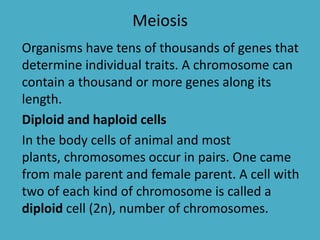
Meiosis
- 1. Meiosis Organisms have tens of thousands of genes that determine individual traits. A chromosome can contain a thousand or more genes along its length. Diploid and haploid cells In the body cells of animal and most plants, chromosomes occur in pairs. One came from male parent and female parent. A cell with two of each kind of chromosome is called a diploid cell (2n), number of chromosomes.
- 2. • Organisms produce gametes that contain one of each kind of chromosome. A cell containing one of each kind of chromosome is called a haploid cell and is said to contain a haploid, or n, number of chromosomes. • Homologous chromosomes The two chromosomes of each pair in a diploid cell are called homologous chromosomes. On homologous chromosomes, these genes are arranged in the same order, but because there are different possible alleles for the same gene, the two chromosomes in a homologous pair are not always identical to each other.
- 3. Why meiosis? • When cells divide by mitosis, the new cells have exactly the same number and kind of chromosomes as the original cells. • Cell division that allows offspring to have the same number of chromosomes as their parents. This kind of cell division, which produces gametes containing half the number of chromosomes as parent’s body cell, is called Meiosis. • Meiosis occurs in the specialized body cells of each parent that produce gametes.
- 4. • Meiosis consists of two separate divisions, known as meiosis I and meiosis II. Meiosis I begins with one diploid (2n) cell. By the end of meiosis II, there are four haploid (n) cells. • These haploid cells are called sex cells— gametes. • Male gametes are called sperm. Female gametes are called eggs. • When a sperm fertilizes an egg, the resulting zygote once again has the diploid number of chromosomes.
- 5. • The zygote then develops by mitosis into a multicellular organism. This pattern of reproduction, involving the production and subsequent fusion of haploid sex cells, is called sexual reproduction.
- 6. The phases of Meiosis • Interphase- The cell replicates its chromosomes. The chromosomes are replicated during interphase that precedes meiosis I, also. • Prophase I – behaves in a similar way to one entering prophase of mitosis. DNA coils, homologous chromosomes line up with each other, gene by gene along their length, to form a four part structure called a tetrad.
- 7. • A tetrad consists of two homologous chromosomes, each made up of two sister chromatids. The chromatids in a tetrad pair tightly. In fact, they pair so tightly that nonsister chromatids from homologous chromosomes can actually break and exchange genetic material in a process known as crossing over. Crossing over results in a new combinations of alleles on a chromosome.
- 8. • Metaphase I- the centromere of each chromosome becomes attached to spindle fiber. Homologous chromosomes are lined up side by side as tetrads. • Anaphase I- The homologous chromosomes move to opposite ends of the cell. • Telophase I- The reverse order from the events of prophase I. The spindle is broken down, the chromosomes uncoil, and the cytoplasm divides to yield two new cells. However another cell division is needed because each chromosome is still doubled.
- 9. The phases of meisois II • The second division in meiosis is simply a mitotic division of the products of meiosis I. • Meiosis II consists of prophase II, metaphase II, anaphase II, and telophase II. Meiosis follows the same steps as the phases of mitosis.
- 12. Meiosis provides for genetic variation • Remember that cells that are formed by mitosis are identical to each other and to the parent cell. • Crossing over during meiosis, provides a way to rearrange allele combinations. Rather than the alleles from each parent staying together, new combinations of alleles can form. • In humans, n= 23, so the number of different kinds of eggs or sperm a person can produce is more than 8 million (2^23). When fertilization occurs, 2^23 x 2^23, or 70 trillion different zygotes are possible.
- 13. • Crossing over can occur almost anywhere at random on a chromosome. This means that an almost endless number of different possible chromosomes can be produced by crossing over, providing additional variation to the variation already produced by the random assortment of chromosome. • This reassortment of chromosomes and the genetic information they carry, either by crossing over or by independent segregation of homologous chromosomes, is called a genetic recombination.
- 14. Nondisjunction • Although the events of meiosis usually proceed accurately, sometimes chromosomes fail to separate correctly. • The failure of homologous chromosomes to separate properly during meiosis is called nondisjunction. • In nondisjunction, both chromosomes of a homologous pair move to the same pole of the cell.
- 15. Nondisjunction • Result: Two kinds of gametes. One has an extra chromosome, and the other is missing a chromosome. When a gamete with an extra chromosome is fertilized by a normal gamete, the zygote will have an extra chromosome. This condition is called trisomy.
- 17. Nondisjunction • In humans, if a gamete with an extra chromosome number 21 is fertilized by a normal gamete, the resulting zygote has 47 chromosomes instead of 46. • This zygote will develop into a baby with Down syndrome. • Organisms with extra chromosomes often survive.
- 19. Nondisjunction • When a gamete with a missing chromosome fuses with a normal gamete during fertilization, the resulting zygote lacks a chromosome. • This condition is called monosomy. • Most organisms do not survive. • Example of monosomy that is not lethal is Turner syndrome, in which human females have only a single X chromosome instead of two.